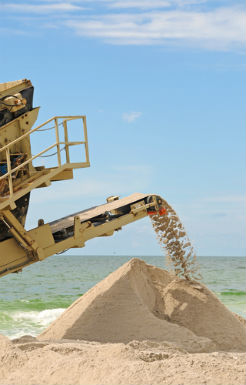
Almost two years after Hurricane Sandy struck New Jersey, officials are declaring the Monmouth County beaches as fully restored and in better shape than they were before the devastating superstorm hit on Oct. 29, 2012, and wreaked havoc on the state's 127-mile coast.
With repairing the beaches, the goal was twofold: To regenerate the vital tourism industry as well as protect property and people from future storms. Work by the Army Corps of Engineers finished in late June for Monmouth County, completing a massive stretch of widened beachfront from the Manasquan Inlet up to Sandy Hook. Officials say the renovated beaches are in better shape now than before Sandy after close to 8 million cubic yards of sand was moved ashore with a pricetag of $109 million.
Robert Martin, New Jersey's environmental protections commissioner, told www.northjersey.com that "these beaches have been repaired and restored to their original design standard, not just to pre-sandy conditions, and will offer enhanced protection from future storms."
Meanwhile, beaches in northern Ocean County, from Bay Head to Berkeley, also weren’t part of the original replenishment project, so they weren’t part of the Army Corps’ repairs over the past year. Bay Head and Mantoloking – the most seriously damaged in that stretch – are still trying to obtain easements from residents. The last easement holdout in Toms River recently agreed to the replenishment projects and township officials now hope the project can start after the summer.
Some property owners in Bay Head are paying out of their own pockets to build a rock wall, or reinforce portions of an existing wall that was damaged in the storm. In Mantoloking, residents approved a steel seawall to help protect their homes. That construction began in June with a New Jersey company called EIC Associates, out of Springfield, handling the work. At a cost of about $40 million, the steel seawall should be complete by November, 2014. The plan calls for 45-ft. high steel sheet pile to be driven vertically 30 feet into the ground, creating the foundation of the seawall that is estimated to cover four miles. The exposed steel will then get covered with sand and will look like a sand dune when it's finished.
Posted by Shawn Clayton on
Leave A Comment